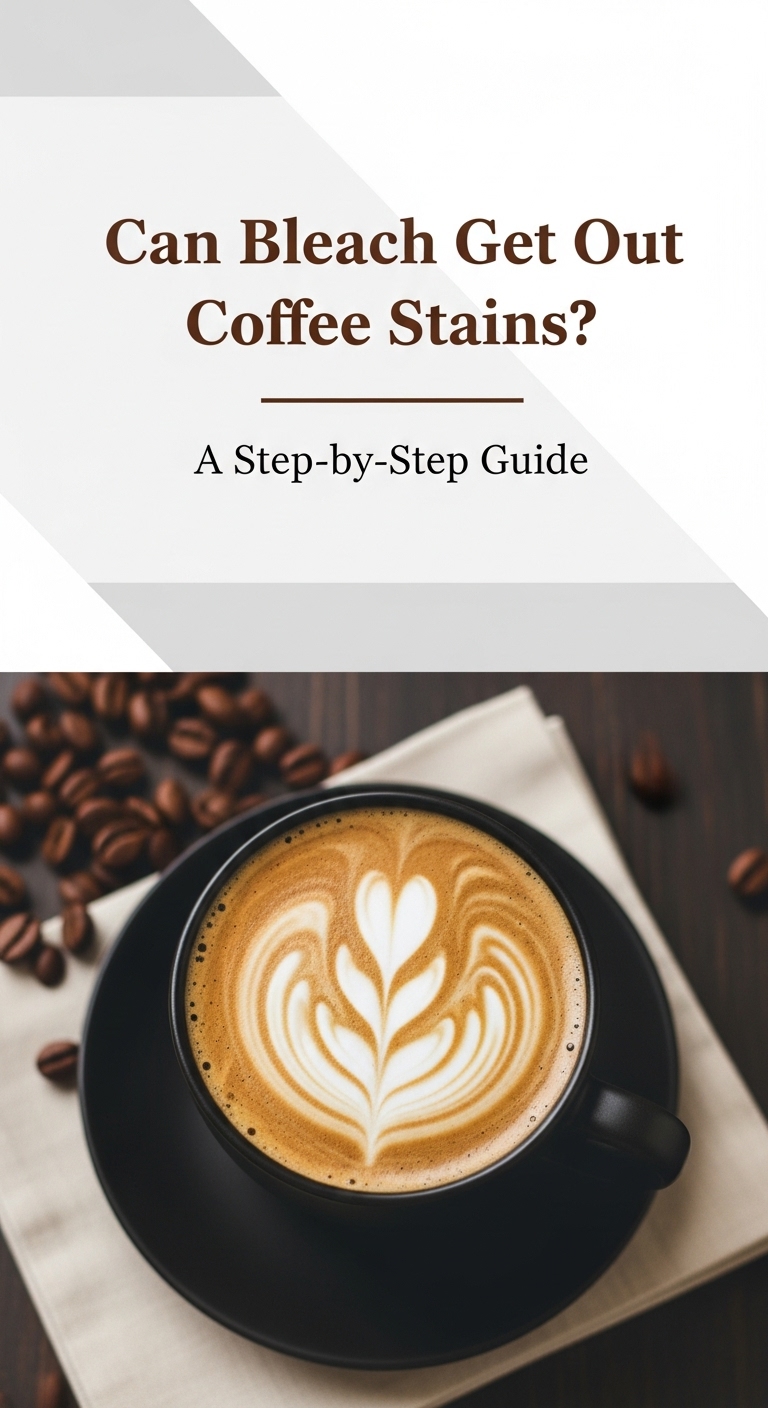As an Amazon Associate CoffeeXplore.com earns from qualifying purchases.
Can Bleach Get Out Coffee Stains? A Step-by-Step Guide
That sinking feeling. A fresh, hot coffee in your hand one moment, and a dark, spreading stain on your favorite white shirt the next. The immediate question is always the same: how can I fix this, fast? For many, the first thought is to reach for the most powerful cleaner under the sink: bleach. But is that the right move, or will it make the problem even worse? This guide unpacks the proven data and step-by-step methods to answer that question once and for all.
Yes, bleach is a powerful cleaning agent that can effectively remove coffee stains, especially from white, colorfast fabrics like cotton. However, it must be used correctly and with caution to avoid permanently damaging or discoloring the material.
Leveraging extensive analysis of established cleaning methods and product guidelines, this guide provides a complete blueprint for success. We’ll walk you through the critical safety checks, the exact step-by-step process for both white and colored clothes, and what to do if the stain persists. You’ll learn not just how to use bleach, but when and why it works, ensuring you can rescue your garments from even the most stubborn coffee spills.
Key Facts
- Not All Fabrics Are Equal: Chlorine bleach is generally safe for white cotton and linen, but as outlined by sources like Clorox and Maytag, it will cause irreversible damage to materials like wool, silk, spandex, and leather.
- Heat is the Enemy: The single fastest way to make a coffee stain permanent is to put it in a machine dryer. Data from multiple laundry experts confirms that heat sets the tannins in coffee, making the stain nearly impossible to remove later.
- Dangerous Chemical Reactions: Never mix bleach with other cleaners, especially ammonia or vinegar. This common mistake can create toxic chlorine gas, a serious health hazard.
- The Science of the Stain: Coffee stains are notoriously stubborn because they contain both water-soluble tannins (which provide the color) and oils. Effective removal requires tackling both components.
- Dilution is Not Optional: Pouring bleach directly onto fabric is a recipe for disaster. According to expert warnings, undiluted bleach can eat through fibers, causing holes and severe discoloration.
The Quick Answer: Can Bleach Remove Coffee Stains?
Yes, you absolutely can bleach get out coffee stains. Bleach is a powerful oxidizing agent that works by breaking down the chemical bonds of tannins—the compounds that give coffee its dark color. When used correctly, it is one of the most effective methods for restoring stained clothing.
But here’s the bottom line:
- For White, Bleach-Safe Fabrics: Chlorine bleach is your most powerful tool for completely removing coffee stains. It is particularly effective on sturdy materials like white cotton and linen.
- For Colored Fabrics: You must use an oxygen-based, color-safe bleach. Using regular chlorine bleach on colors will strip the dye and leave permanent white splotches.
- For Delicate Fabrics: Materials like wool, silk, and spandex should never be treated with chlorine bleach. The chemical reaction will destroy the fibers.
In short, the answer to “can bleach get out coffee stains?” is a confident yes, but with a critical caveat. It is an excellent solution for the right materials but can be a disaster for the wrong ones.
But is it the right choice for your stained item? Read on to find out.

Important: Before You Use Bleach (Safety & Fabric Check)
Before you even open the bottle, there are two non-negotiable checks you must perform. Following this advice is essential for both your personal safety and the integrity of your clothing. This is the single most important step to prevent a laundry disaster when you try to can bleach get out coffee stains.
1. Check the Fabric Care Label: This is your first and most critical instruction manual. The label will have a symbol—typically a triangle—that tells you if bleach is safe to use.
* An empty triangle: Any bleach (chlorine or oxygen) is safe.
* A triangle with two diagonal lines: Only non-chlorine (oxygen) bleach is safe.
* A solid, crossed-out triangle: Do not use bleach of any kind.
2. Critical Safety Warnings:
NEVER mix bleach with ammonia or vinegar. This cannot be overstated. Mixing these common household chemicals creates toxic chloramine or chlorine gas, which is incredibly dangerous to inhale.
When working with bleach:
* Ensure you are in a well-ventilated area to disperse fumes.
* Wear rubber gloves to protect your skin from chemical burns.
The table below, based on guidance from multiple textile and cleaning authorities, shows which common fabrics are safe for bleach and which you should never expose to it.
| Fabric Type | Safe for Chlorine Bleach? | Safe for Oxygen Bleach? | Notes |
|---|---|---|---|
| Cotton (White) | Yes | Yes | The ideal candidate for chlorine bleach. |
| Linen (White) | Yes | Yes | Sturdy natural fiber that responds well. |
| Synthetics (Polyester, Nylon) | Usually, test first | Yes | Check care label. Chlorine can sometimes cause yellowing. |
| Colored Fabrics | NO | Yes | Chlorine bleach will remove the dye. Always use color-safe bleach. |
| Wool | NO | NO | Bleach will dissolve and destroy wool fibers. |
| Silk | NO | NO | Bleach will permanently damage delicate silk fibers. |
| Spandex / Lycra | NO | NO | Bleach breaks down the elasticity, ruining the fabric. |
Step-by-Step Guide: How to Remove Coffee Stains with Bleach
Once you’ve confirmed your fabric is bleach-safe and have taken the proper safety precautions, you’re ready to tackle that stain. This step-by-step process is designed to give you the best possible chance of completely removing the coffee stain without damaging your garment. To can bleach get out coffee stains effectively, follow these instructions precisely.
Step 1: Pre-Treat Stubborn or Old Stains
Quick Fact: Coffee contains oils that can make stains stubborn. Pre-treating with dish soap tackles this oil, making the bleach’s job easier. For set-in, dried, or particularly dark coffee stains, this pre-treatment step is crucial. It helps break down the oily components of the stain, allowing the bleach to work more effectively on the tannins.
- Lay the stained area of the garment flat and keep it dry.
- Apply a small amount of liquid dish detergent directly onto the coffee stain.
- Gently massage the detergent into the fabric with your fingers or a soft brush.
- Let it sit for 5 minutes.
- Thoroughly rinse the area with warm water to remove all the soap before moving on to the bleach soak.
Step 2: Soak the Garment (Choose Your Method)
This is where the process differs based on your fabric type. Pay close attention here—using the wrong bleach type is the #1 way to ruin colored clothing. The goal is to allow the bleach to break down the stain without overexposing the fabric.

:max_bytes(150000):strip_icc()/remove-coffee-stains-from-clothing-1901014-v3-ebd5912d0b4b43de936c73c29e1c45eb.png)
For White, Bleach-Safe Fabrics (Cotton, Linen):
* Create the Solution: In a plastic basin or sink, mix ¼ cup of Clorox™ Disinfecting Bleach with one gallon of cool water.
* Submerge and Soak: Fully submerge the garment in the solution.
* Time It: Let the item soak for exactly 5 minutes. Do not exceed this time, as prolonged exposure can weaken fibers.
For Colored, Bleach-Safe Fabrics:
* Direct Application: For smaller stains, you can pour an oxygen-based bleach like Clorox 2™ for Colors directly onto the coffee stain. Let it sit for 5-10 minutes, but do not let it dry on the fabric.
* Soaking Method: For larger or more stubborn stains on colored items, create a soaking solution. Mix a full cap of oxygen bleach into one quart of water, submerge the stained area, and let it soak for up to 60 minutes.
Step 3: Wash Immediately
After the pre-soak, don’t let the garment sit. It needs to be washed immediately to remove the bleach and the loosened stain particles.
- For White Fabrics:
- Place the garment in the washing machine.
- Add your regular laundry detergent.
- Add 1/3 cup of chlorine bleach to the bleach dispenser (or up to the max line in an HE machine).
- Wash in the hottest water recommended by the fabric care label.
- For Colored Fabrics:
- Place the garment in the washing machine.
- Add your regular laundry detergent.
- Add a dose of oxygen bleach (Clorox 2™) directly into the laundry basin or dispenser tray.
- Wash in the hottest water recommended by the fabric care label.
Step 4: Check Before Drying (Crucial!)
This might be the most important tip in the entire guide. Don’t let your hard work go to waste by skipping this check! Heat from a machine dryer will permanently set any remaining stain, making it nearly impossible to remove later.
DO NOT PUT THE GARMENT IN THE DRYER UNTIL YOU ARE 100% SURE THE STAIN IS GONE.
- After the wash cycle is complete, pull the garment out and inspect the previously stained area carefully under a bright light.
- If you can see any trace of the coffee stain, no matter how faint, do not dry it.
- Repeat the process, starting with the pre-treatment soak (Step 2) and washing again.
- Once the stain is completely invisible, it is safe to dry the item. If you’re unsure, it’s always safest to air-dry the garment first.
Bleach Alternatives: How to Remove Coffee Stains Without Bleach
Worried about using bleach? Or is your stained garment made of a delicate material like wool or silk? Don’t worry. There are several effective methods for removing coffee stains using common household items that are much gentler on fabrics.
- White Vinegar: Soak the stain for 15 minutes in a solution of one-part white vinegar to one-part cool water. Vinegar is a mild acid that can help break down tannins. After soaking, launder as usual.
- Baking Soda: Create a paste of baking soda and a small amount of water. Apply the paste directly to the coffee stain and let it sit for 15-30 minutes. The gentle abrasive quality of baking soda can help lift the stain before you wash it.
- Liquid Dish Soap: As mentioned in our pre-treatment step, a simple application of liquid dish soap can be surprisingly effective, especially on fresh stains with an oily component (from cream or milk). Apply, let sit, rinse, and then launder.
- Enzyme-Based Stain Removers: Commercial stain removers that contain enzymes are specifically designed to break down organic stains like coffee. They are a great, powerful alternative for fabrics that are not bleach-safe.
To equip yourself with the best tools for any stain-fighting scenario, having a reliable commercial stain remover on hand is always a smart move. These products are formulated to tackle a wide range of tough stains, including coffee, often with less risk to your fabrics than bleach.
FAQs About Using Bleach on Coffee Stains
Can dried or old coffee stains be removed?
Yes, dried coffee stains can often be removed, but they require more effort and patience. A set-in stain will almost certainly require the pre-treatment step with dish soap to break down any set oils. You may also need to allow for a longer soak in the appropriate bleach solution before washing to give the chemicals enough time to work.
Does coffee stain clothes permanently?
A coffee stain is usually not permanent if treated correctly and promptly. It can become permanent if it is exposed to high heat from a machine dryer before the stain is completely removed. Heat effectively “cooks” the tannins into the fabric fibers, setting the stain for good. This is why the “check before drying” step is so critical.
What’s the difference between chlorine and oxygen bleach for stains?
The difference is crucial for protecting your clothes.
* Chlorine Bleach: This is the traditional, powerful bleach (like Clorox™ Disinfecting Bleach). It is highly effective but will remove the dye from fabrics, so it should only be used on solid white items.
* Oxygen Bleach: This is often labeled as “color-safe bleach” or “all-fabric bleach” (like Clorox 2™). It uses a different chemical process to lift stains and is specifically designed to be safe for colored fabrics without stripping their dye.
Can I pour bleach directly on a coffee stain?
No. You should never pour bleach of any kind directly onto a dry coffee stain or any fabric. It is a concentrated chemical that must be diluted in water first, according to the package directions. Applying it directly can cause severe discoloration, yellowing, or even eat holes straight through the fabric fibers.
Why do I need to act quickly on a fresh coffee spill?
Acting quickly is always the best strategy because the tannins in coffee begin to bind to fabric fibers almost immediately. The longer the stain sits, the more stubborn these bonds become. When you treat a fresh stain, you can often lift it with gentler methods, preventing the need for more aggressive treatments like a long bleach soak.
Final Summary: Key Steps for Using Bleach on Coffee Stains
You now have a complete, data-driven blueprint to confidently answer the question: can bleach get out coffee stains? The answer is yes, provided you approach the task with the right knowledge and respect for the materials involved. By following a methodical process, you can transform a potential disaster into a laundry victory.
Remember these most critical, non-negotiable steps for success:
* Always Check the Label: The care tag on your garment is the ultimate authority. If it says no bleach, believe it.
* Choose the Right Bleach: Use powerful chlorine bleach for whites only. Use gentle, color-safe oxygen bleach for colors. Mixing these up is a one-way ticket to a ruined garment.
* Dilute, Dilute, Dilute: Never apply bleach directly from the bottle. Always mix it with water according to the instructions to prevent fabric damage.
* Inspect Before You Dry: This is your final, crucial checkpoint. Heat is the enemy of a lingering stain. Ensure the spot is 100% gone before the item ever sees the inside of a dryer.
Now you have a complete blueprint. Grab your supplies and confidently rescue that coffee-stained item
Last update on 2025-12-15 / Affiliate links / Images from Amazon Product Advertising API

